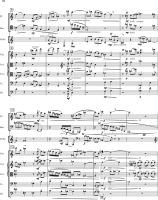From the Forest of Chimneys [17']
IV from From the Forest of Chimneys
From the Forest of Chimneys was written for the New York Philharmonic Chamber Ensembles at the suggestion of bassoonist Leonard Hindell, who had asked for a work for a large chamber complement. Wallach scored the work for a mixed octet of winds and strings. The wind group, consisting of clarinet, bassoon and horn, is identical to the winds called for in the Beethoven Septet and the Schubert and Hindemith Octets. The string group is somewhat unusual, however, consisting of violin, two violas, cello and bass. The substitution of a second viola for the normal second violin darkens the overall color, and gives greater prominence to the higher-register melodies.
Recorded by the Milken Archive of Jewish Music, From the Forest of Chimneys is an extended lyrical work for eight instruments, each with an equally crucial and characteristic solo role. The work took shape on my 1991 trip to Poland.
On a dark, misty day, I visited the site of the Birkenau extermination camp. When the Nazis realized that the Russians would advance through Poland, they attempted to eliminate evidence of their inhumane activities by bombing the Birkenau crematoria and gas chambers and setting fire to the barracks. All that now remains, as far as the eye can see, is a forest of chimneys stretching to the horizon.
From the watchtower near the camp’s entrance, I looked out on that forest of chimneys, and on the spirals of mist curling up around one another, intertwining and dispersing like the truncated songs of the many victims whose lives had been cut short in that tragic place. These curling helices of song and mist are the central image of From the Forest of Chimneys. The work was completed during the summer and fall of 1991 at the Virginia Center for the Creative Arts and in New York City. It is in four movements, each subdivided into long lyrical sections. In each section, the characteristic extended melodies unfold as they pass seamlessly from one instrumental voice to another. As each instrument yields the melodic line, its voice assumes a supporting role and the motives come to be tinted differently. The timbre is thus refracted into subtle coloristic differentiations as the material is passed among the players.



